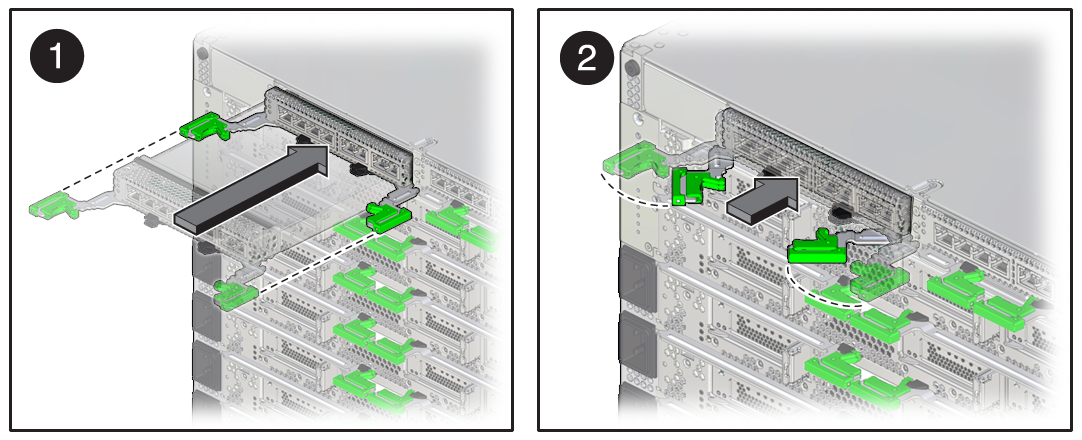Install an SP or SPP
An SPM will automatically restart following the installation of an SP or SPP.
Caution - If you remove this component while the server is powered on, wait 30 seconds before installing the replacement component. Doing so ensures that Oracle ILOM has enough time to detect the new component, which is required for the software to power it on. |
 | Caution - The SPARC M8-8 servers include SPs that are not compatible with the SPARC M7 servers. Never install a SPARC M8 SP in a SPARC M7 server, and never install a SPARC M7 SP in the SPARC M8-8 server. |
-
Take appropriate ESD measures.
See Prevent ESD Damage.
-
Insert the SP into the slot, and slide it in until the extraction levers start
to close.

-
Close the extraction levers fully until they lock into place.

-
Determine whether an FPGA update is required and update the firmware, if
needed.
If an FPGA update is required, refer to the SPARC M8 and SPARC M7 Servers Product Notes for information about performing the update.
-
Reinstall the cables you removed from the NET MGT and SER MGT ports.
Ensure that you install the cables in the same ports from which you removed them.
- Connect a terminal or a terminal emulator (PC or workstation) to the SER MGT port.
-
If needed, download the system firmware.
The Active SP will replicate the system firmware on the newly installed SP or SPP. Confirm that the correct system firmware is running. If an update is needed, update the system firmware on the Active SP (not on the newly installed SP or SPP) as follows.
-
Configure the network port on the Active SP to enable the firmware
image to be downloaded.
For instructions, refer to the Oracle ILOM documentation.
-
Download the system firmware and install it on the Active SP.
Follow the firmware download instructions in the Oracle ILOM documentation and refer to the SPARC M8 and SPARC M7 Servers Product Notes for the current firmware version.
Note - You can load any supported system firmware version, including the firmware revision that had been installed prior to the replacement of the SP or SPP.
-
Configure the network port on the Active SP to enable the firmware
image to be downloaded.
-
Restore the configuration information.
-> cd /SP/config -> load -source uri target
where:
-
uri is tftp, ftp, sftp, scp, http, and https
-
target is the remote location where you stored the configuration information
For example:
-> load -source tftp://129.99.99.99/pathname
-
-
(SPARC M7 servers only) If TPM was
initialized on the replaced SP, complete these steps:
-
Reinitialize TPM and reset the tpmadm failover
command if it was previously in use.
For information about initializing TPM using the Oracle ILOM interface to enable failover, see Securing Systems and Attached Devices in Oracle Solaris 11.3.
-
Restore the TPM data and keys that were backed up to the Standby SP on
a new SP you install.
For information about migrating or restoring TPM data and keys, see Securing Systems and Attached Devices in Oracle Solaris 11.3.
-
Reinitialize TPM and reset the tpmadm failover
command if it was previously in use.
- Verify that the fault has been cleared and the replaced component is operational.
-
Verify that the SP date is correct.
-> show /SP/clock /SP/clock Properties: datetime = Tue Sep 07 08:09:59 2013 timezone = GMT (GMT) uptime = 0 days, 00:01:18 usentpserver = disabled ->-
Set the datetime property, if necessary.
-> set /SP/clock datetime=MMDDhhmmYYYY
-
Set the timezone property, if necessary.
-> set /SP/clock timezone=3-to-4-characters
where the timezone value equals a three- or four-character timezone abbreviation, such as EST.
-
Set the datetime property, if necessary.
- Return the replaced component to Oracle.
Related Information
-
Oracle ILOM documentation (http://www.oracle.com/goto/ilom/docs)